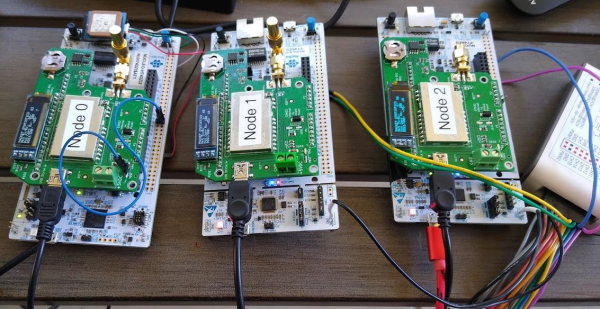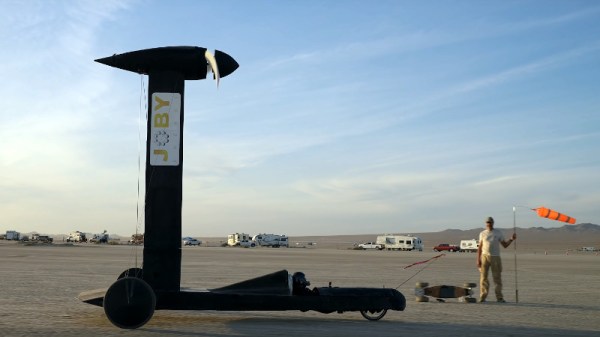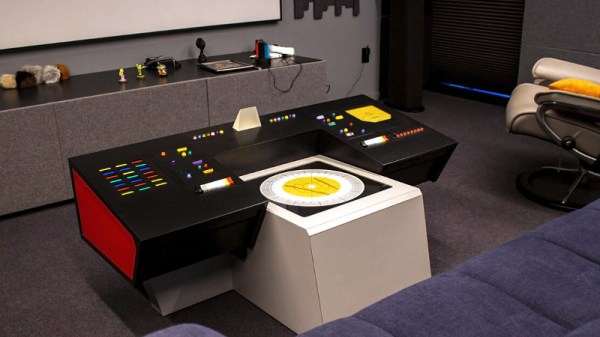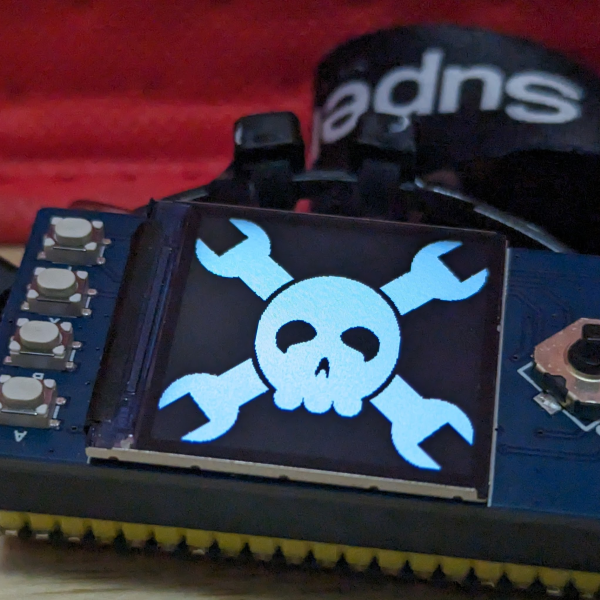There are a bunch of newly minted millionaires this week, after it was announced that Stack OverFlow would be acquired for $1.8 billion by European tech investment firm Prosus. While not exactly a household name, Prosus is a big player in the Chinese tech scene, where it has about a 30% stake in Chinese internet company Tencent. They trimmed their holdings in the company a bit recently, raising $15 billion in cash, which we assume will be used to fund the SO purchase. As with all such changes, there’s considerable angst out in the community about how this could impact everyone’s favorite coding help site. The SO leadership are all adamant that nothing will change, but only time will tell.
Year: 2021
QMESH: LoRa Mesh Networked Voice Communications
LoRa is great for sending short data packets over long ranges but is not normally suitable for voice communications. [Dan Fay] is looking to change this with QMesh, a synchronized, flooded mesh network protocol for ham radio applications.
In a flooded mesh network every node repeats every message it receives. This has the theoretical advantage of making the network self-healing if a single node stops working, but often just means that the nodes will interfere with each other. Thanks to some characteristics of LoRa, [Dan] is using several tricks to get around this packet collision problem. LoRa network can make use of the “capture effect”, which allows a receiver to differentiate between two packets if the power level difference is large enough. This is further improved by adding forward error correction and slightly changing the frequency and timing of the LoRa chirps. QMesh also implements TDMA (Time Division Multiple Access) by splitting transmission into time slots, and only transmitting every third slot. This means it is operating on a 33% duty cycle, which is much higher than the 0.1%-10% allowed on license-free ISM-bands, which legally limits it to the ham bands.
On the hardware side, [Dan] has been using the STM32 NUCLEO-144 development boards with F4/L4/F7/H7 microcontrollers and a custom shield with a 1 W LoRa module and OLED screen. While [Dan] wants to eventually build handheld radios, he plans to first develop small FM repeaters that encode voice as codec2 and use QMesh as a backhaul. QMesh is still under development, but we would love to see the results of some long-range testing, and we are excited to see how it matures.
If your interested in a more basic LoRa-based human-to-human messaging system, take a look at Meshtastic. It’s been going very rapidly over the past year. To learn more about LoRa and other digital modulation schemes, check out the crash course we did with an SDR a while back.
Sailing Faster Than The Wind Itself
If you search the outer reaches of the internet you will find all sorts of web sites and videos purporting to answer to free energy in the form of perpetual motion machines and other fantastical structures that bend the laws of physics to breaking point. We’d love them to be true but we have [Émilie du Châtelet] and her law of conservation of energy to thank for dashing those hopes. So when along comes a machine that appears to violate a fundamental Law of Physics, it’s reasonably met with skepticism. But the wind-powered vehicle built by [Rick Cavallaro] looks as though it might just achieve that which was previously thought impossible. It’s a machine that can move with the wind at a speed faster than the wind itself.
A fundamental law of sailing boats is that when they are sailing with the wind, i.e. in the same direction as the wind, they can’t sail faster than the wind itself. Sailing boats can go faster than the wind powering them by sailing across it at an angle to create lift from their sails, but this effect doesn’t work as the angle tends towards that of the wind.
The vehicle in the video below the break is a sleek and lightweight machine with a large propeller above it, which we are told is not the windmill power source we might imagine it to be. Instead it mimics the effect of a pair of sailing boats sailing across the wind in a spiral around a long cylinder, and thus becomes in effect a fan when turned by the motoin in the craft’s wheels. The drive comes from the wind working on the craft itself, and thus as can be seen from the motion of a streamer on its front, it can overtake the wind. It seems too good to be true at first sight but the explanation holds water. Now we want a ride too!
For fairly obvious reasons, the fantastical world of pseudo-physics isn’t our bag here at Hackaday. But if something might hold promise we’ll at least give it a look. Not all such things we cover turn out to change those Laws of Physics, though.
Differential Drive Doesn’t Quite Work As Expected
Placing two motors together in a shared drive is a simple enough task. By using something like a chain or a belt to couple them, or even placing them on the same shaft, the torque can be effectively doubled without too much hassle. But finding a way to keep the torque the same while adding the speeds of the motors, rather than the torques, is a little bit more complicated. [Levi Janssen] takes us through his prototype gearbox that attempts to do just that, although not everything works exactly as he predicts.
The prototype is based on the same principles as a differential, but reverses the direction of power flow. In something like a car, a single input from a driveshaft is sent to two output shafts that can vary in speed. In this differential drive, two input shafts at varying speeds drive a single output shaft that has a speed that is the sum of the two input speeds. Not only would this allow for higher output speeds than either of the two motors but in theory it could allow for arbitrarily fine speed control by spinning the two motors in opposite directions.
The first design uses two BLDC motors coupled to their own cycloidal drives. Each motor is placed in a housing which can rotate, and the housings are coupled to each other with a belt. This allows the secondary motor to spin the housing of the primary motor without impacting the actual speed that the primary motor is spinning. It’s all a lot to take in, but watching the video once (or twice) definitely helps to wrap one’s mind around it.
The tests of the drive didn’t go quite as planned when [Levi] got around to measuring the stall torque. It turns out that torque can’t be summed in the way he was expecting, although the drive is still able to increase the speed higher than either of the two motors. It still has some limited uses though as he notes in the video, but didn’t meet all of his expectations. It’s still an interesting build and great proof-of-concept otherwise though, and if you’re not clear on some of the design choices he made there are some other builds out there that take deep dives into cycloidal gearing or even a teardown of a standard automotive differential.
Continue reading “Differential Drive Doesn’t Quite Work As Expected”
Is 32-bits Really Dead?
While some of us are still clinging onto our favorite 8-bit microprocessors, ARM announced they will be killing off the 32-bit architecture in 2022 and/or 2023. Over on the GaryExplains YouTube channel, [Gary Sims] posted a great review of the current 32- vs 64-bit state-of-affairs — not just for ARM but for Intel and AMD processors as well. And it’s a dismal outlook for you 32-bit fans.
ARM announced last Fall that there would be no more 32-bit support as of 2022, then this March they made a similar announcement but with a 2023 deadline. [Gary] tries to parse these statements, and takes an educated guess at what the disparity means (spoiler alert — he predicts that one more 32-bit core will soon be released).
[Gary] clearly breaks down the 32-bit situation by operating systems such as Linux, Windows, MacOS, Android, and iOS, and how all of these have been transitioning to 64-bits over recent years. He does a thorough job, and concludes that the transition is already well underway. And while Linux and Windows have not completely dropped 32-bit support, the writing is on the wall.
Take note, however, that this discussion regards the Cortex-A family of cores found in smart phones, tablets, computers, and powerful embedded applications like autonomous vehicles. The popular 32-bit Cortex-M family of low-cost / low-power cores that are used in so many embedded system designs will remain 32-bits for the foreseeable future.
After watching [Gary]’s presentation, if you want to learn more, check out the writeup that [Maya Posch] did on the details of the latest ARMv9 ISA a few weeks ago. Also watch this 8-bit vs 32-bit presentation by our Editor-in-Chief [Mike Szczys]. Despite being from five years ago, it is still quite applicable today. What about 16-bit MCUs — the old Intel/AMD embedded 80186 processor, the 8051 follow-ons like the 80C196, 80C251, or 8051XA, the 6502 follow-ons like the 65C816, Zilog’s Z8000, the Renesas M16C, etc. — is anyone using them anymore? If so, or if you’re using a 4-bit MCU these days, let us know in the comments below.
Baby C-17 Sends Imaginations Soaring
The C-17 Globemaster III is a military cargo jet that can carry what their commercial counterparts can’t, to places those other planes can’t go. The people who keep these planes flying are proud of their capable airlifter, but it’s hard to show them off. Solution: build a scaled-down version more suitable for driving off base for a parade down Main Street and other community events.
While the real thing was built under an expensive and contentious military procurement process, the miniature was built with volunteer labor using castoff materials. The volunteer force included maintenance crew whose job is to know the C-17 inside and out. Combined with fabrication skills that comes with the job, the impressive baby plane faithfully copied many curvatures and details from full-sized originals. (Albeit with some alteration for its cartoony proportions.) Underneath are mechanicals from a retired John Deere Gator utility vehicle. They usually resemble a large golf cart except with a cargo bed and more rugged suspension. Basically they are to golf carts as a C-17 is to a 767. Amusingly, the little plane has its own rear loading ramp, superficially preserving the cargo-carrying capacity of the original Gator chassis.

Interior features continue, though the official picture gallery doesn’t show them. There is a flight deck with control panels and various sights and sounds to keep visitors entertained. Enough details were poured into the exhibit that some people had to ask if the little plane can fly, and the answer is a very definite no. The wings, and the engine pods mounted to them, are only for show carrying The Spirit of Hope, Liberty & Freedom. It is quite a long official name for such a short stubby thing.
We always love to admire impressively put-together miniatures, and not all projects require skill of aircraft mechanics. Like this very approachable miniature forklift project. But there are plenty of other projects whose skills put us in awe, like this remote-control car powered by a miniature V-10 engine.
[via The Museum of Flight]
Enterprise Helm Commands The Entertainment Center
Many a young geek wished they could get a chance to sit at the helm of the USS Enterprise, wildly tapping on unlabeled technicolor buttons with the self-assured confidence of a proper Starfleet officer. For most of us it was a dream unrealized, but right now somebody in the Seattle, Washington area is getting to do exactly that in their media room. We won’t deny being jealous, but at least our collective egos can take some comfort in the knowledge that they had to outsource the construction of their replica helm to the fine folks at [Blackmouth Design].
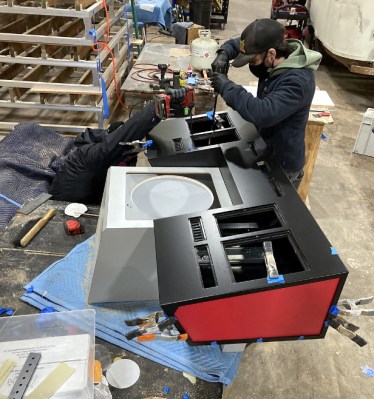 There’s not a lot of technical details to be had, but considering the page for this project is only meant to show off the company’s design and fabrication skills, we can’t blame them too much. If we were in the business of selling these things, we’d probably keep some of the juicer details under wraps too.
There’s not a lot of technical details to be had, but considering the page for this project is only meant to show off the company’s design and fabrication skills, we can’t blame them too much. If we were in the business of selling these things, we’d probably keep some of the juicer details under wraps too.
But we do know there’s “Arduino technology” under the hood that fires up different light and sound effects depending on which of the vintage rocker switches has been flipped. The red momentary buttons lined up on the right side of the coffee table sized panel are tied into the home media center to do things like turn off the lights and lower the projector screen. Check out the video below for a brief demo.
In a post on Reddit, one of the engineers behind the project explains that the top surface of the helm is 3/16″ powder coated aluminum, with the plywood that makes up the base laminated in the classic Original Series color scheme of red, grey, and black. The artwork for the astrogator was created from scratch, backlit with LEDs, and placed behind a 1/4″ acrylic panel for protection. We imagine the fact that it’s parallel to the ground means it’s supposed to be a space to place your drinks or popcorn, though if it was in our house, nobody would be bringing food or drink anywhere near it.
In all honesty, while Hackaday is decidedly more about building than buying, we can’t fault anyone for forking over their hard earned cash for craftsmanship of this caliber. After all, we’ve had our eyes on that officially licensed tricorder replica for quite some time now.
Continue reading “Enterprise Helm Commands The Entertainment Center”


